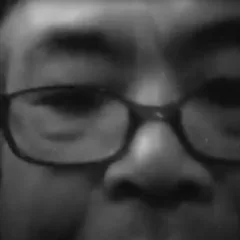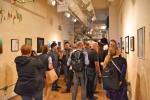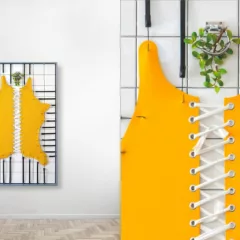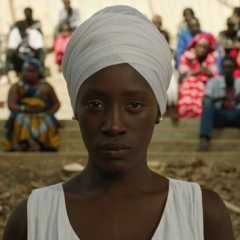Post by Marianne Bernstein
In his book The Empathic Civilization, economist Jeremy Rifkin, investigates the evolution of empathy. Recent scientific studies suggest that we are wired for collaboration. Our natural impulse is to get along with our native kin; which over time have evolved from our fellow cave men, to our state, country, or religion, to the planet at large. When we are prevented from engaging with others openly the best parts of ourselves are repressed, and this results in narcissism, fear, anger, and violence. However, when we see ourselves in each other, harmony often ensues. We have an innate desire to thrive. Which brings me to the Tate Modern.
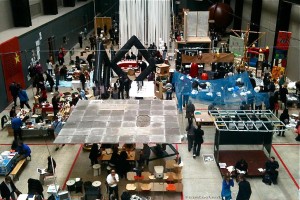
The Festival of 80 alternative art spaces from around the world called No Soul For Sale was invited into London’s cavernous Tate Modern Turbine Hall from May 14-16. The brainchild of Maurizio Cattelan, Cecilia Alemani, and Massimiliano Gioni, “No Soul For Sale” had its first incarnation at the X-Initiative in NYC, where many of these same international, non-commercial spaces gathered to inspire and challenge us to re-imagine new possibilities for contemporary art.
In London the rules were the same as in NYC: free admission, no walls, and nothing for sale, while offering up a free exchange of ideas and discourse with young artists trying to keep art, and perhaps even the planet alive. Groups came from Philadelphia (Vox Populi and FLUXspace), Barcelona, Dublin, Istanbul, Rio de Janiero, Seoul, Vancouver, Prague, Paris, Edinburgh, Hong Kong, Beirut, Los Angeles, Oslo, Tel Aviv, Berlin, New York, Paris, Reykjavik, London, Chicago, Jerusalem, Milan, Kyoto, Portland, Leeds, Seattle, Basel, Liverpool, Tangier, and beyond. (The weekend event was part of Tate Modern’s 10th anniversary celebration.)
Most of these alternative spaces and organizations are formed by young artists. They are not utopian, far from it, but they still manage to make decisions by consensus; members encourage one another’s creativity, build bridges, reaching out into the community and world at large. How do they flourish? Why do they fail? Most will not survive. Many artists will move on. How can we nurture them? Or do they even need nurturing, surviving in part by being renegade?
I visited No Soul for Sale because alternative spaces are close to my heart, having founded one- (untitled) space in New Haven, CT.- a decade ago. Here’s my report.
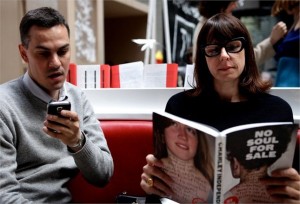
Friday, May 14th It’s late afternoon when I visit No Soul For Sale with my son Jake, a 23 year old musician, who has just flown into Heathrow from San Diego to join me and is extremely jet-lagged. His eyes look dazed as we survey the chaotic scene. “I don’t get it,” he says, “But maybe it’s just me.” My response is: This is a Festival, much like a Festival of bands at say, Warp Tour. It’s an overview and we are getting a glimpse into a fresh creative wave that is happening worldwide. I take him back to rest, and he doesn’t return. Jake, however has spent the last six years collaborating, traveling, playing, sharing ideas, (with very few material possessions) writing songs, filming, photographing. Art making in general has become much more interdisciplinary, and interestingly enough some of the best artists I know are also musicians. Their creativity spans mediums; it is fluid and defies boundaries.
Saturday, May 15 I return to the Turbine Hall and stay for eight hours. The Hall has become a free-for-all, a zany romper room, a big party, a youthful United Nations, with artists crammed together in very small spaces outlined on the floor with red tape. The room is humming wildly like a hive of bees inside a juke-box. But now I am ready to focus and excited to take part. First stop is to hug the FLUXspace team.
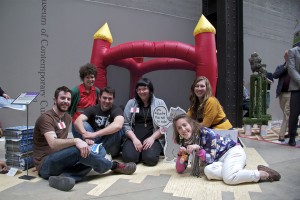
Everyone is there! They had packed their very believable red, blue, and yellow hand-sewn plastic cat bounce and little kitten mittens, T-shirts, tote bags, signage. With everything in their luggage, and barely scraping by, they made their way to claim their fame at the Tate Modern. Turns out they are on the front and back cover of the No Soul For Sale catalogue as well! FLUXspace’s installation reminds me of the Pablo Helguera “What in the World” installation during Philagrafika. Like Helguera, Flux is making a sly nod to the slippery slope of an “objective” study of history , as well as referencing the wildly popular website I Can Has Cheezburger.
According to FLUX, cats die out as a species by 2019, and as intrepid archaeologists of the future, FLUX researchers are trying to make sense of the artifacts left behind. They come to the following conclusions: Kittens wore mittens, jumped on kitten moon bounces, kitty litter had chocolate bars in it.
It is fun watching the crowd interact with FLUX. One young boy turns his face up to them with a sweet little “meow” hoping they might mistake him for a kitten and let him jump inside the bounce. The artwork looks so real I believe most people don’t realize it is hand-fabricated. Another woman quizzically asks them: is this Post-modernism? All the while FLUX staffers keep straight faces as they sadly explain what cats used to do back in the day when they roamed the earth.
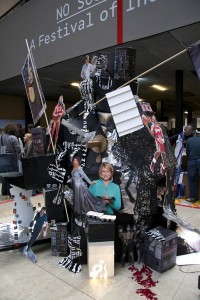
Vox Populi, also representing Philly, creates an enormous collaged sculptural “clump” in the middle of the room packed with images from modern day politics and pop culture, cut out from trashy American magazines. It is daring in its blatant randomness and ugliness, and on closer inspection I find it quite amazing. The longer I look at the pile, the more lost I feel, which I believe is the whole point. I give Vox a lot of credit, they have been around since 1988 and have found a way to consistently show challenging and experimental work.
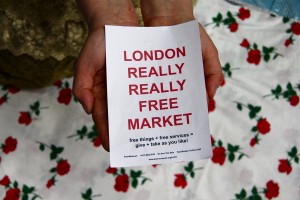
Post-Museum from Singapore has visitors leaving secrets on post-it-notes. One of the artists invites me to sit down on “a bed of roses (a soft cotton fabric with tiny red roses on it), gives me her Polish mum’s yeast cake recipe, and reads my palm so accurately that I burst into tears. With tears welling in her eyes, she holds my hand for a few minutes and gives me some much needed advice. Their advertising is simple: LONDON REALLY REALLY FREE MARKET (free things and free services; give +take as you like). It sets the tone for the entire afternoon.
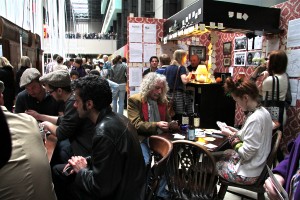
Black Dogs from Leeds, UK seem to have figured out how to make the most out of being stuck in Turbine Hall from 10am-10pm non-stop for three days. Having created their own bar, they are doing what they do back home, drinking lots of beer and playfully engaging with the public in ways “that provide a working alternative to capitalist society.” Café tables invite everyone to sit and chat with one another, and if you want to you could write down on a beer coaster the answer to the Big Question: PLEASE TELL US: HOW NOT TO SELL YOUR SOUL?
Feeling very thirsty, I sidle up to the bar and ask if I can have a beer. Of course they aren’t allowed to serve me. I am very disappointed in that, but hey, we are at the Tate Modern, not in Leeds.
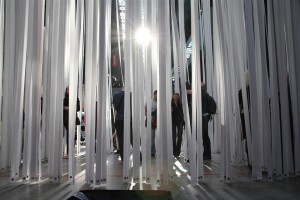
Streams of unrolled receipt paper, weighted at the bottom by free-falling Icelandic krona coins, cascade from the high Turbine ceilings, brought to us by Kling and Bang. One of the true standouts, K&B, like the Festival itself, is slightly melancholy, constantly in flux, changing color in the evening light, billowing as it shelters us inside, giving us permission to come and go as we wish. Inhaling and exhaling, it invokes an essential theme of our times — re-examining and recycling breakdown, to rebuild something new.
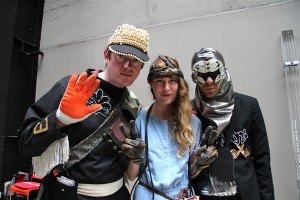
And then there are “the plant people” from Oregon Painting Society whose desire (not mission) is “to discover and sustain a state of highly generative interpersonal communion.” Turns out the buzzing sounds (remember, it sounds like a beehive) are primarily coming from their spot. Three artist-musicians (two men and a woman, who live and work together communally) — all gorgeous and decked out in the most incredible costumes — hook up plants to electronic music so that they vibrate to the touch. I don’t think anyone leaves Turbine Hall the same after transforming into a human conduit between those plants. It’s perhaps as close to the Garden of Eden as we’ll ever get; hands and leaves holding onto one another for dear life.
98 weeks (Beirut) and L’appartement 22/ R22 radio (Beirut) share a common quality– bravery. It’s one thing to be an alternative space in a country that supports the arts, quite another to put your life on the line. I love L’appartement’s postcard: A photo of the Tate Modern has Arabic scrolled over it which translates: Know Thy Worth.
Alternative Space (Loop) in Seoul, Korea may well nurture “young defiant Asian artists” but they have somehow also managed to score an entire futuristic building reminiscent of Frank Gehry’s Guggenheim Bilbao back home, where they produce a consistent stream of gorgeously-designed catalogues and posters and have a thriving media center and gallery. I wonder who is footing the bill. This is most unusual in these times.
Arrow Factory located in a former vegetable stand and storefront in Beijing prides itself on their often surprising interactions with the neighborhood, free of “commercial entanglements.” In their storefront, artists take turns inhabiting the space at street-level, jarring people out of their everyday routine. They do not hold openings and subsist on small contributions from friends. They impress me with the starkness of their Turbine Hall installation, a large gleaming, gold plaque on a makeshift wall with a cheesy photo of a sunset over water which reads: My Soul For This. I ask them if they think they have sold their soul to come to the Tate Modern, and their response is: What do you think?
Artis-Contemporary Israeli Art Fund showcases an Israeli artist’s repurposing of cigarette lighters, which have holes drilled into the center reminiscent of Yertzeit candles for the dead. Both Arabic and Hebrew letters are on all of their literature and I ask them if they are commissioning Arab artists as well. The Director’s response: We are trying, but it’s hard. We are doing the best we can.

Rhizome, the electronic art project of the New Museum, which has been around since 1996, had their friends MAIL NOTHING TO THE TATE MODERN. Hundreds of packages with their tracking numbers made available is part performance, part sculpture and allows one to grasp our vast global infrastructure: “a breathing system of objects in continuous motion.”
The Museum of Everything brought to you by the Isle of Wight and “Everywhere else you can think of” is on the upper floor, and I almost miss it. Dedicated to art by “the unsung creators of this modern world,” it invites passersby to donate a work, which is voted by a panel inside to be worthy or not. Those works selected are displayed around the Museum’s exterior walls. When I stop by, a child’s drawing has just been selected, and I have to admit, it is very good. To date, I believe their collection includes over 500 works, by children, outsider or visionary artists, circus artists, and artists with disabilities.
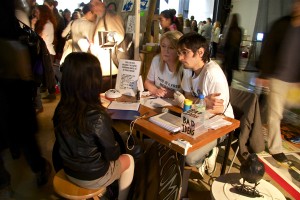
Along the same lines, The Royal Standard (Liverpool) invites visitors to submit A GOOD IDEA. A long desk is set up. A panel of judges confers and votes on whether they think your idea is a good one or not. If selected, your good idea is uploaded to their website and made public on a computer screen. When I’m there, the panel is very taken with a young lady around age 12. I don’t stick around to find out what her idea is but the judges seem to like it. I notice that the jar of BAD IDEAS is full.
Postscript
I returned to the States, energized and awake. Artists have always been the agents of social change and we need them now more than ever. Cohabitation isn’t easy, it’s full of struggle and pain, but that’s life, isn’t it? As the Black Dog boys from Leeds so aptly put it: “Art is a mode of living to be unearthed and experimented with in the everyday”. The future of our planet depends on it.
–Marianne Bernstein has been living in Philadelphia since 2001. She is on the FLUXspace Exhibitions Advisory Committee. Her curatorial and artistic work incorporates text, photography, performance and video.


